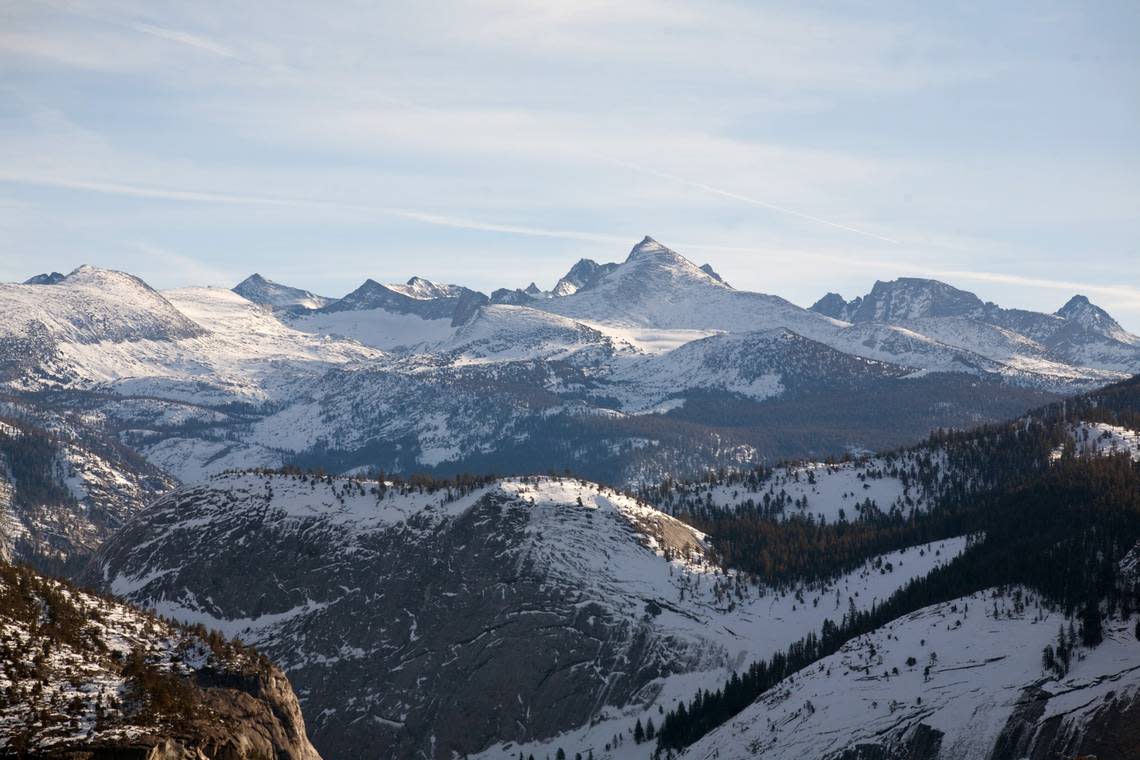Yosemite glaciers among the endangered in new report of UNESCO World Heritage sites
Glaciers in Yosemite National Park were included on a list of endangered glaciers that are “very likely” to disappear by 2050, according to a new study by UNESCO in partnership with the International Union for Conservation of Nature.
A third of the glaciers across 50 UNESCO World Heritage sites, including Yosemite, are expected to disappear within the next 30 years, regardless of efforts to curb global warming, states the UNESCO report released this week. Its findings indicate the remaining World Heritage site glaciers might still be saved if temperature rises don’t exceed 1.5 degrees Celsius compared to the pre-industrial period.
The 18,600 glaciers identified across the 50 World Heritage sites represent about 10% of the Earth’s glaciers. They include the highest glacier, next to Mount Everest, and the longest, in Alaska.
“Glaciers are of critical importance for sustaining life on Earth,” UNESCO said. “They provide vital water resources to half of humanity. They have an important cultural and religious significance for many local communities, and attract millions of tourists globally.”
#WorldHeritage glaciers cover almost 10% of the Earth’s glaciered area & play a crucial role in sustaining life on Earth.
Discover what makes these outstanding places not only unique, but essential to all life.@IUCN & @UNESCO's latest report has more: https://t.co/Jp9pyJ99Rv pic.twitter.com/7D5iifUWyF— UNESCO #Education #Sciences #Culture (@UNESCO) November 4, 2022
Yosemite National Park glaciers
Yosemite’s two glaciers, the Lyell and Maclure glaciers, at the headwaters of the Tuolumne River, could disappear much sooner. Yosemite National Park geologist Greg Stock expects them to melt away within the next five to 20 years.
“Glacier loss will decrease the flows of the upper Tuolumne River, especially during drought years,” Stock said, “with impacts to downstream ecosystems.”
Technically, Yosemite’s Lyell Glacier is no longer a glacier, because glaciers move, by definition. Stock said the most accurate description now is that Lyell is a stagnant ice patch. He thinks it could have stagnated sometime in the early 2000s. Surveys this year confirmed it no longer moves, Stock said, because it is no longer thick enough to flow.
The Maclure Glacier is still moving, Stock said, but has slowed since it was last measured 10 years ago.
“Since they were first mapped and photographed in 1883, the Lyell and Maclure glaciers have lost about 90% of their ice volumes,” Stock said, “meaning that what remains is 10% of what was first photographed in 1883.”
Yosemite park rangers described conditions at Lyell in an April update for the National Park Service.
“As we traversed below what was once the Lyell Glacier it wasn’t difficult to envision the disappearing snow and ice across the globe,” the rangers wrote. “The glacier is now considered an stagnant ice patch because it is no longer moving downhill and is rapidly diminishing in size. Not only is there less annual global coverage of snow and ice but it has been melting earlier. ...
“This spring in Yosemite, the river flows are peaking in early April instead of late May or June. Just remember that if you live in the American West, your water probably came from the sky in the form of a beautiful, delicate snowflake. Each and every dendrite is as beautiful and as important as all life on this fragile little planet including you! So please, take care of one another and our only home, Mother Earth.”

Urgent action needed to save what’s left
Urgent action is needed to safeguard these unique places for future generations, the study found.
“Half of humanity depends directly or indirectly on glaciers as their water source for domestic use, agriculture, and power,” UNESCO said. “Glaciers are also pillars of biodiversity, feeding many ecosystems.”
Other endangered glaciers in North America include those in Yellowstone National Park, which are also “very likely” to disappear by 2050. In Waterton-Glacier International Peace Park, straddling Canada and Montana, glaciers have lost 26.5% of their volume over the past 20 years.
“This report is a call to action,” UNESCO Director-General Audrey Azoulay said. “Only a rapid reduction in our CO2 emissions levels can save glaciers and the exceptional biodiversity that depends on them.”
In addition to drastically reducing carbon emissions, UNESCO is advocating for the creation of an international fund for glacier monitoring and preservation. Such a fund would support research, improve communication between stakeholders, help reduce risks, and help warn people of danger.
Glaciers studied by UNESCO have been retreating at an accelerated rate since 2000 due to carbon dioxide omissions, the report states, and are currently losing 58 billion tons of ice every year, equivalent to the combined annual water use of France and Spain. These melting glaciers are also responsible for nearly 5% of observed global sea level rises.
“When glaciers melt rapidly, millions of people face water scarcity and the increased risk of natural disasters such as flooding,” IUCN Director General Bruno Oberle said, “and millions more may be displaced by the resulting rise in sea levels.”
